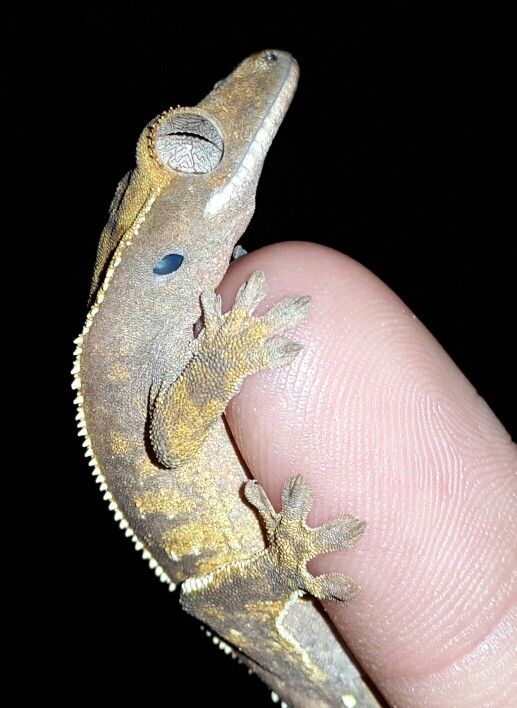How to feed a baby crested gecko
Baby and Juvenile Crested Gecko Care (With Shopping List)
When you first get a crested gecko, you’ll probably get an older juvenile or even adult crested gecko as they are easier to handle. However, if you’re a more experienced owner you can get a baby crested gecko. Baby cresties are easier to bond with and you’ll get the opportunity to learn how to care for a crested gecko in almost every stage of its life: hatchling, juvenile, adult.
Baby crested geckos, also called hatchlings and juveniles, require special housing and require high humidity to shed their skin. They will need an appropriate diet to grow and become healthy adults. Baby crested gecko care isn’t difficult but you should be more delicate when handling them.
When talking about baby crested geckos in this article I mean both hatchlings and juveniles. Crested geckos are called juveniles in the stage up to their adulthood (around 18 months).
While older juvenile crested geckos (for example 6 months and older) aren’t really “baby crested geckos” anymore, I’ve included them here for convenience. You’ll notice that at certain points I’ll be making the distinction between younger and older juvenile crested geckos. Older juveniles can sometimes be compared to adult crested geckos in their needs and care.
If you want to learn more about the care for adult crested geckos you should definitely read the following article about crested gecko care.
Baby Crested Geckos
Baby crested geckos will hatch from their eggs after 2 to 3 months. The baby crested gecko will still be very little, measuring between 2.5 and 3 inches (6.5 to 7.5 centimeters) and weighing around 2 grams. The size and weight can depend on several factors such as genetics and incubation temperature.
You should weigh and measure your baby crested gecko each week. A kitchen scale can be used for this reason. The table below shows you the average growth rate of baby crested geckos.
| Age | Weight |
|---|---|
| 1 month | 2 grams |
| 2 month | 3 grams |
| 3 month | 4 grams |
| 4 month | 5 grams |
| 5 month | 7 grams |
| 6 month | 9 grams |
To learn more about the growth rate of crested geckos check out this article.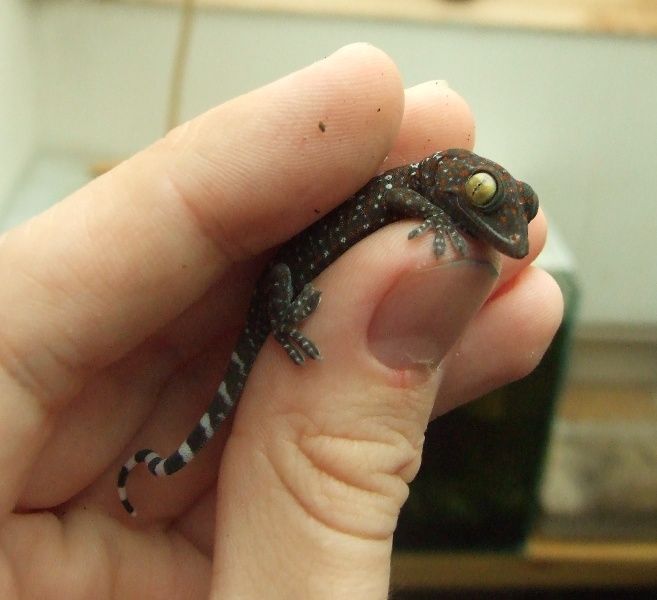
How to Handle a Baby Crested Gecko
Baby crested geckos are tiny and can be very fast which makes them less easy to handle, especially for a beginner. They also aren’t used to handling and will try to jump away which can be a bad thing when they don’t have something to jump on and fall on the ground.
It’s advised not to start handling a baby crested gecko until it’s a bit older (six months and older). The exception to this is that you’ll need to handle them to weigh and measure them and to clean the container. When you do handle a baby crested gecko always be careful and don’t grab it by its tail. This can easily lead to stress and tail loss.
Housing a Baby Crested Gecko
Baby crested gecko care shares similarities with the housing of adult crested geckos. They both need a humidity between 50 and 80 percent. The temperature should also be between 72 and 78 ° F (22 to 26 °C) during the day and 69 and 74 °F (20 and 23 °C) during the night. Indirect sunlight or artificial light should be provided 12 to 14 hours a day. At night, no special lighting is needed.
At night, no special lighting is needed.
The differences in housing a baby crested gecko are on three major points: the enclosure, the substrate, and the plants.
Enclosure for baby crested geckos
Baby crested geckos (up to 10 grams) can be kept in small containers and don’t need to be kept in a terrarium. It’s even better to keep them in smaller containers or tanks that have a minimum size between 1.5 and 5 gallons such as a faunarium or a very small terrarium (8″x 8″x 12″). Juveniles between 10 and 25 grams can be kept in the first small terrarium between 7 and 10 gallons.
Hatchlings and juveniles will need these smaller enclosures because they’ll often have trouble finding food in a larger cage. They only need a small environment that has a few plants or branches and don’t need an entire system with climbing possibilities.
Some adult crested geckos will have trouble adjusting to larger terraria because they’re not used to the size of the terrarium. You can try to get your crested gecko adjusted to a larger sized terrarium by gradually switching to larger enclosures as the baby crested gecko grows up.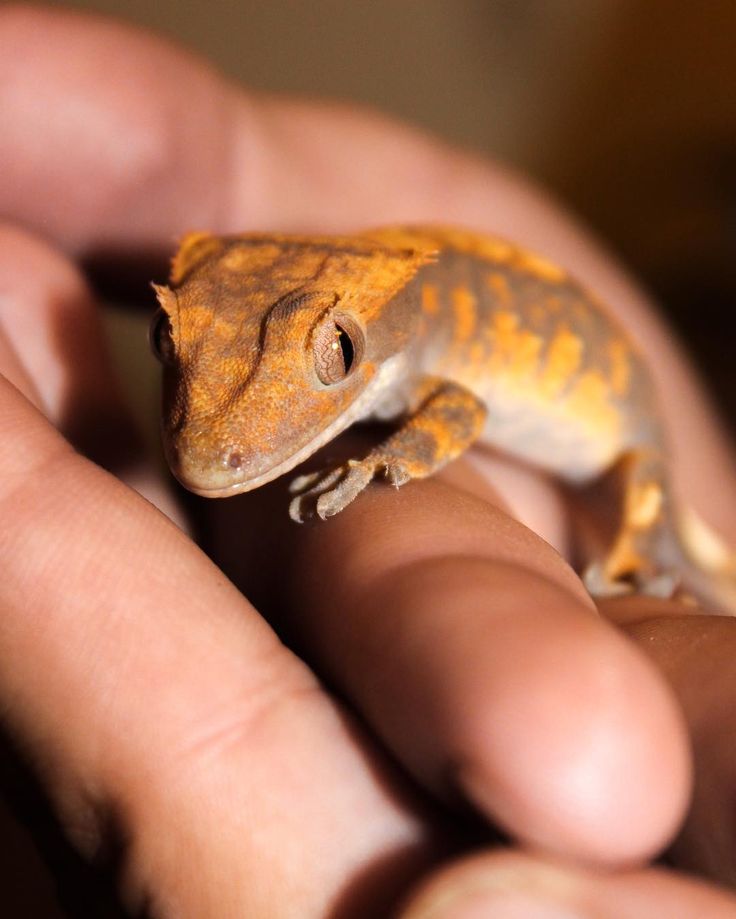
Substrates for baby crested geckos
Baby crested geckos are tiny and are miniature versions of adult crested geckos. Since they’re tiny you can’t use the same kind of substrate for baby crested geckos as you would for adults.
The substrate for baby crested gecko should have a low ingestions risk and should be able to be cleaned easily. This eliminates a lot of substrate types and only leaves you with two options since bark and soil can easily be ingested.
I would recommend that you use one of these substrates for your baby crested gecko:
- no substrate: if you don’t use a substrate in a terrarium for a baby crested gecko there’s obviously no risk of ingestion. There’s however a risk associated with using no substrate. The high humidity that baby crested geckos need will lead to the buildup of water on the surface of the terrarium. There’s also an added risk that bacteria will build up without a substrate. So, daily cleaning will be necessary.

- paper substrates: a more popular substrate for baby crested geckos is paper. It’s a cheap and safe way to provide a first substrate for the babies to walk on. You can use old newspapers or paper towels and can even continue to use them as your baby crested gecko grows older. It’s possible that your hatchling tears up the paper and will try to eat it. In such a case, you can opt for butcher paper, which is a lot sturdier and is less likely to tear.
Older juveniles can be kept in a terrarium with more naturalistic substrate but my recommendation is to be careful and wait until your crested gecko is adult before you get a substrate with an ingestion risk.
Terrarium plants and branches
Terrarium plants are useful to provide a hiding place and a way to climb around and explore the enclosure. Live terrarium plants are useful to increase the humidity and to give a more natural look to the terrarium. However, baby crested geckos benefit more from fake vines. A small container also isn’t a good place to fill with live plants.
A small container also isn’t a good place to fill with live plants.
Get one or two small branches and a small number of fake plants or vines to create hiding places. At least half of the container should be free of foliage just like the terrarium of an adult crested gecko.
When you house your older juvenile crested gecko in a terrarium, you can start with keeping live terrarium plants.
Baby Crested Gecko Diet
Dietary basics
The yolk sack of which hatchling comes has enough nutrients for a hatchling to last for the first days. It’s entirely possible that your baby crested gecko doesn’t eat the very first days.
A baby crested gecko will usually eat after its first shedding, which happens within 2 to 3 days after hatching. To be certain that your crested gecko has food you should place food in the container 24 to 48 hours after hatching.
Since crested geckos are omnivores they feed on both animal and plant matter. Although baby crested geckos can be fed a self-made fruit diet it’s best to stay use commercial crested gecko food like meal replacement powders. These contain all nutrients your baby crested gecko needs.
These contain all nutrients your baby crested gecko needs.
Feeding insects to baby crested geckos
Insects can be introduced fairly quickly, about a month after hatching. These crickets shouldn’t be bigger than the width of your crested gecko’s head. Baby crested geckos usually are able to eat small crickets that measure between ⅛ inch to ¼ inch depending on the size of your baby crested gecko.
The insects should be gut-loaded and dusted with calcium and D3 powder. A baby crested gecko can consume two crickets about every other day although this is not always recommended when feeding a commercial diet.
Water
Baby crested geckos need water but will usually drink droplets of water that remain after misting. You should however also place a water bowl in the container. This bowl should contain only a shallow amount of water to prevent the accidental drowning of your crested gecko.
What Do You Need for Baby Crested Geckos?
You can find everything you’ll need for both baby, juvenile, and adult crested geckos in our shopping list.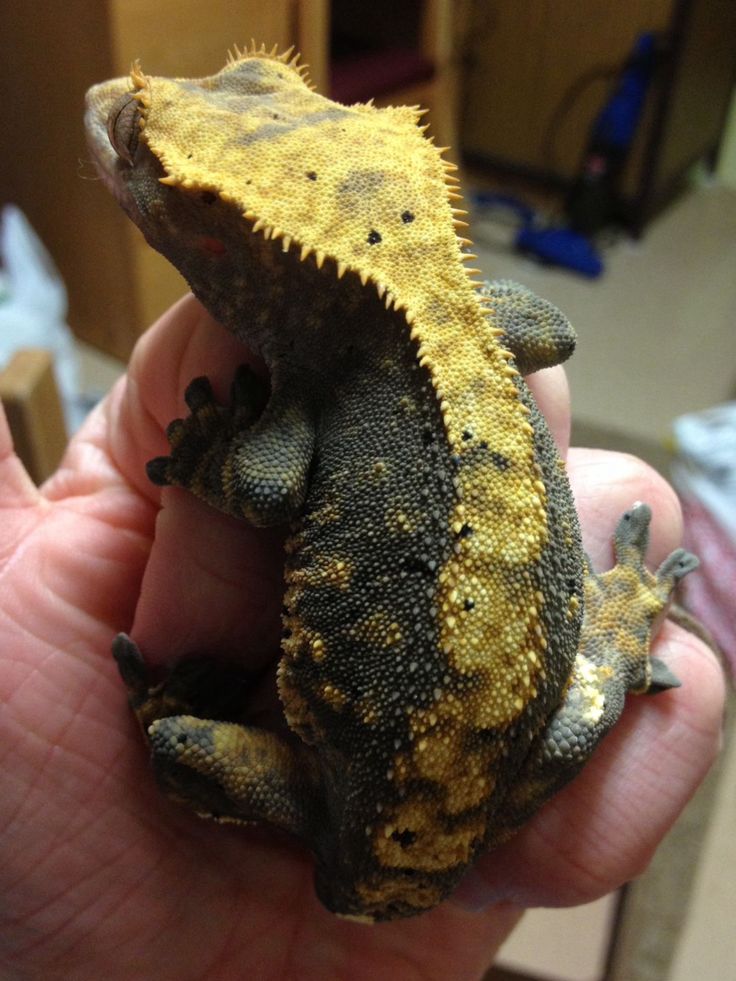
Baby crested geckos will start with a few decorations and (fake) plants in their container or tank but will eventually need a larger terrarium that can be filled with all kinds of decorations, plants, vines, and branches.
If you don’t want to search to collect all essentials for caring for your baby crested gecko you might want to consider a starter kit. A good crested gecko starter kit contains almost everything to start (except for food and feeding ledges).
Do baby crested geckos eat every day?
Baby crested geckos don’t need to eat every day but can eat every other day just like adult crested geckos. Depending on the kind of diet you give you can feed them every day to promote growth.
Can baby crested geckos be housed together?
Baby crested geckos can be housed together in a large enough terrarium. You should however separate them when they grow larger and can’t fit in a normal terrarium. It’s recommended to separate them at six months.
Want to Learn More?
If you want to learn more about crested geckos as pets, please read the following articles.
If you’re interested in getting crested geckos as pets you should also definitely read our article about (adult) crested gecko care.
Kevin N.
Kevin is the owner of My Crested Gecko. He wrote this blog for many years and has been a geckos enthusiast his entire life, but only became an official "geckophile" five years ago when he acquired one as a pet! Kevin knows how to care for hamsters, guinea pigs, rabbits, and degus in addition to crested geckos which are more than happy with him every day!
Baby Crested Gecko Care Guide!
Disclaimer: As an Amazon Associate I earn from qualifying purchases. Therefore, we may collect a share of sales from the links on this page, at no extra cost to you!
Baby Crested Gecko Care
Whether you’re getting a baby crested gecko from the pet store or your adult gecko’s eggs just hatched, taking care of such a tiny little gecko can feel a bit daunting!
And if it is your first time with such a young reptile, you’re probably second-guessing your every move.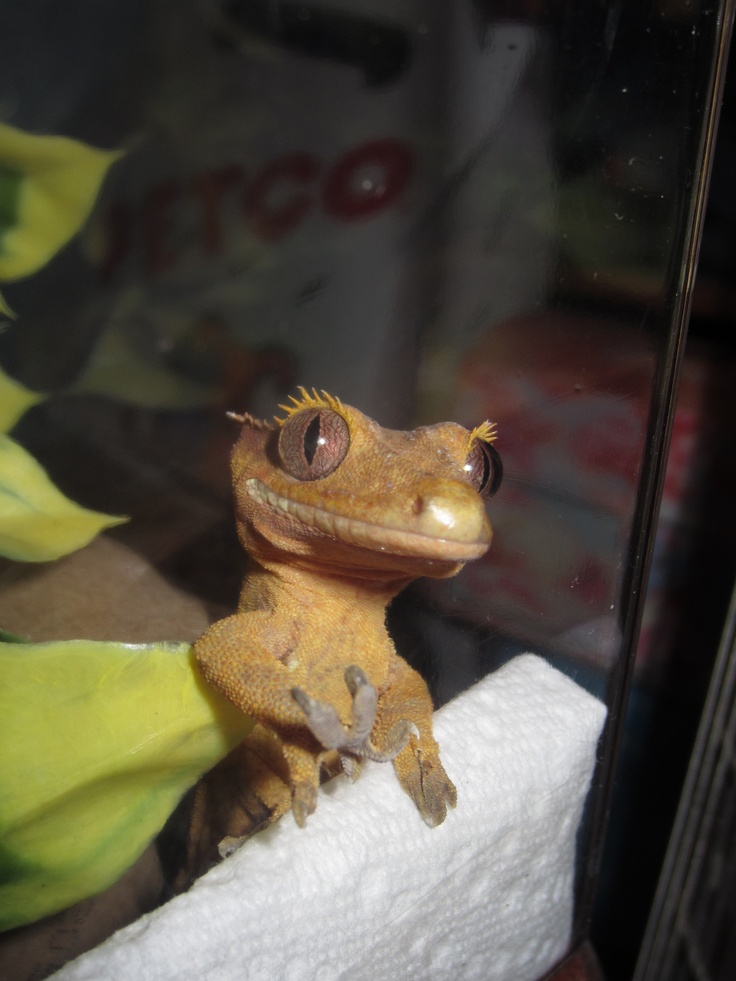
So, how do you take care of a baby crested gecko?
You will be relieved to learn that caring for baby and juvenile crested geckos is very similar to caring for adults, albeit with a few changes here and there.
However, don’t worry – we’re here to help! This article will cover taking care of both hatchlings and juvenile crested geckos up to 6 months old.
Throughout this article, we’re going to cover everything from costs, diet, enclosure, handling, and more! Keep reading to learn more!
Jump to..
How Much is a Crested Gecko? What About Supplies?
One of our cute little cresties!If you’re like me, the first thing on your mind is probably cost. Of course, if you already own a crested gecko, you can move onto the next section. However, if you haven’t already gotten your baby crested gecko, you’re going to want to gather everything you need beforehand.
So, what is the total up-front cost of purchasing everything you need for a crested gecko?
Well, there’s a few factors that come into play. One of the biggest factors is where you decide to shop. If you go to a pet store such as Petsmart or Petco, you’re going to end up spending a lot more than you would if you buy everything online.
One of the biggest factors is where you decide to shop. If you go to a pet store such as Petsmart or Petco, you’re going to end up spending a lot more than you would if you buy everything online.
I personally shop on Amazon for all of my reptile supplies. Therefore, here’s a rough breakdown of the costs associated with buying a crested gecko:
- Tank/enclosure – $150 (See my recommendation)
- Artificial plants – $10 (See my recommendation)
- Artificial vines – $10 (See my recommendation)
- Substrate – $15 (See my recommendation)
- Food/water dish – $15 (See my recommendation)
- Temperature gauge – $10 (See my recommendation)
- Spray bottle – $5 (See my recommendation)
- Food – $20 (See my recommendation)
So, you’re probably going to spend around $235 once you purchase everything needed to provide for your crestie. The crested gecko itself will vary in price depending on the morph. The morph is essentially the color scheme or pattern found on the crestie. Some of the more rare morphs (such as the Tricolor Harlequin and the Tiger) cost upwards of $500. However, on average, a baby crested gecko will probably cost around $40.
The crested gecko itself will vary in price depending on the morph. The morph is essentially the color scheme or pattern found on the crestie. Some of the more rare morphs (such as the Tricolor Harlequin and the Tiger) cost upwards of $500. However, on average, a baby crested gecko will probably cost around $40.
Therefore, everything together (supplies + the crested gecko itself) will probably cost you around $275.
Feeding a Baby Crested Gecko
Hungry crested gecko!Once you get a hatchling or juvenile gecko, your biggest concern will probably be feeding them. What do they eat? How often do they eat? What nutrients do they need?
Well, don’t worry. Providing for them is not as complicated as it may seem. In fact, it’s just a slight modification to what you would feed to an adult crested gecko.
Hatchlings
Because the energy of their yolk sacs can sustain hatchlings for some time, they usually don’t eat for a couple of days after hatching.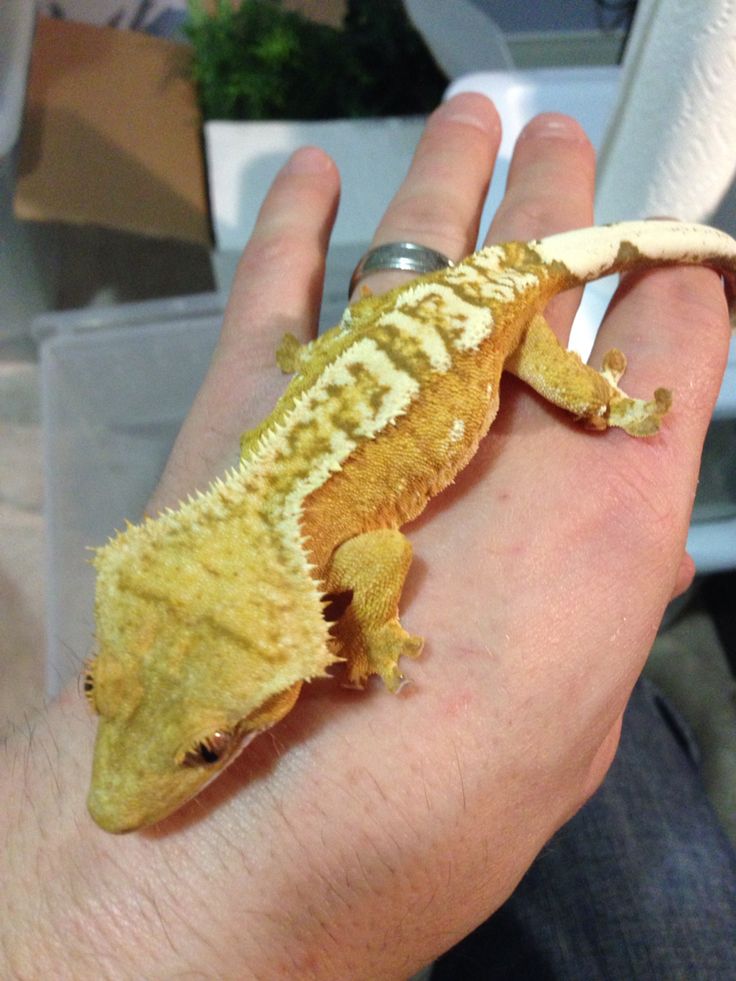 However, you should provide some food a day or two after hatching just in case they feel hungry.
However, you should provide some food a day or two after hatching just in case they feel hungry.
Dietary needs
While crested geckos are omnivores and can eat both plant and animal-sustained diets, you will want to strictly feed your baby crested gecko commercial gecko food.
This is basically a powdered substance that you mix with water. Here is an example of what it looks like:
Commercial diet for baby crested geckosThe reason why it’s so crucial for baby crested geckos is because they have very demanding nutritional needs that live bugs and fruits simply can’t meet.
We personally use Pangea Fruit Mix Fig & Insect Diet for our baby crested geckos as it tastes delicious and contains all the essential nutrients for your crestie to grow healthy and strong.
You can find it on Amazon here:
Preparing the commercial gecko diet is very simple: It’s 1 part powder to 2 parts water. You can put the food in a small ceramic bowl or disposable cup. I personally use disposable cups so I don’t have to clean out a ceramic bowl each time I feed my crested geckos.
I personally use disposable cups so I don’t have to clean out a ceramic bowl each time I feed my crested geckos.
When your baby crested gecko is around a month old, you can start introducing gut loaded insects dusted with calcium and D3 powder. A crestie’s favorite is crickets, but make sure they’re small enough for your baby gecko to eat comfortably.
However, if you don’t want to feed your crested gecko any live insects, they can survive on commercial crested gecko diet alone.
Pro tip: Make sure any bug you decide to feed your crested gecko is smaller than their head!
You can also include a treat like mashed fruit, but these should be kept at a minimum.
Such delicious treats may make for an excellent way to win over your reptile, but they don’t really provide the nutrients a baby crested gecko needs to grow.
We advise you to feed mashed fruit to your baby gecko once or twice a month.
In the wild, baby crested geckos usually drink droplets of water from the dew. However, since it’s difficult to recreate this in an enclosure, place a small bowl of water inside the enclosure instead. Ensure that the bowl is shallow to protect your reptile from drowning and change the water daily.
However, since it’s difficult to recreate this in an enclosure, place a small bowl of water inside the enclosure instead. Ensure that the bowl is shallow to protect your reptile from drowning and change the water daily.
Housing a Baby Crested Gecko
Baby crestie hanging on a vine!Enclosure
Fortunately, crested geckos don’t require large enclosures like other reptiles such as the bearded dragon. A 5-10 gallon tank should be plenty of space for a juvenile crested gecko. For adult geckos, you’ll want to upgrade to a 20-gallon enclosure.
Crested geckos are arboreal (meaning they love to climb), so a tall enclosure is your best option. The Exo-Terra 12 x 12 x 18 Inches Reptile Enclosure is the tank we use for both our baby and adult crested geckos and it works perfectly.
The ideal tank for a crested gecko should have the following characteristics:
- Tall, rather than wide
- Plenty of ventilation (screen top)
- Lots of space for climbing and other activities (10-20 gallons)
- Escape-proof
To give you a better idea on the size/layout of a crested gecko tank, here’s a picture of our crested gecko’s enclosure:
Our crested gecko enclosureSubstrate
Due to their small size, you will also have to be careful about the substrate type you use in your reptile’s enclosure. It should be hard to ingest while being easy to clean. You don’t want anything soft enough for them to bite off and swallow or small enough to be devoured in one bite. Therefore, things like soil, coco fiber, and tree bark should be avoided.
It should be hard to ingest while being easy to clean. You don’t want anything soft enough for them to bite off and swallow or small enough to be devoured in one bite. Therefore, things like soil, coco fiber, and tree bark should be avoided.
In your quest to completely eliminate the risk of ingestion, you may be tempted to use no substrate at all. But this comes with some risks and added responsibility. The high humidity in the enclosure will condense on the terrarium’s surface, and water will build up, making for an uncomfortable existence for your juvenile gecko. There is also an added risk of bacteria buildup, and you will have to clean the enclosure daily.
Paper substrates are great for baby crested geckos under 15 grams. Many people use old newspapers or paper towels as the first substrate for their juvenile reptiles. These provide an excellent surface for your baby crested gecko, and they’re not easy to bite off, hence reducing the risk of ingestion. If you need a more robust paper substrate just in case your crestie can tear through paper towels; butcher paper is an excellent alternative. For hygienic purposes, remember to replace the paper substrate every week.
For hygienic purposes, remember to replace the paper substrate every week.
Temperature and Humidity
Just like with the adults, baby crested geckos require a temperature specific environment. To thrive, your baby crestie will need temperatures between 70 and 80 degrees during the day and 69 and 74 degrees Fahrenheit at night.
Therefore, you won’t need any heating bulbs for your crestie. Typically, they thrive in room temperature environments. However, anything warmer than 80 degrees can result in heatstroke or other health issues for your gecko.
On the other hand, crested geckos do require vitamin D3. This is essential for the development of your crestie.
This can be acquired in two ways. Your first option is to dust your crested gecko’s insects with calcium powder. Alternatively, you can purchase a UVB bulb that will rest on the roof of your enclosure.
Personally, I prefer using a UVB bulb since it requires less work and you don’t have to worry about giving your crested gecko the proper amount of calcium powder that they need.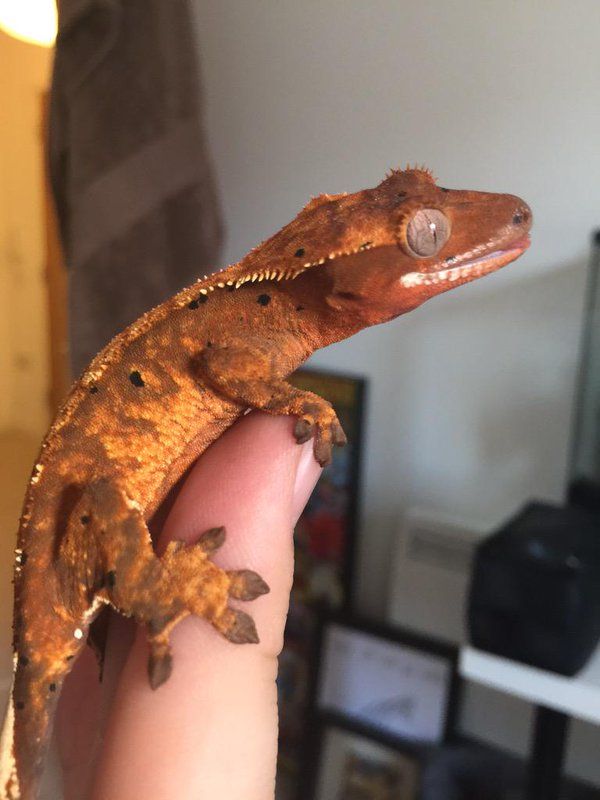 However, this is entirely up to you.
However, this is entirely up to you.
If you are interested in purchasing a UVB bulb, we have a detailed lighting guide that includes all the best bulbs on the market.
Additionally, crested geckos also require relatively high levels of humidity, usually between 50% and 80%. Their small size and high surface area to volume ratio also means that baby crested geckos quickly dehydrate. Hence, keeping a shallow water bowl and regularly misting the tank should help regulate the humidity and reduce dehydration.
Terrarium plants and branches
Plants and branches are a useful feature in a terrarium. They give the enclosure an attractive, natural look, increase the humidity, provide a way for the crested gecko to explore their home, and form a cool hiding place.
But since baby cresties live in small enclosures, adding live plants is probably not a great idea. This is because the plants will take up a lot of space as they grow, which may cause your crestie to feel suffocated.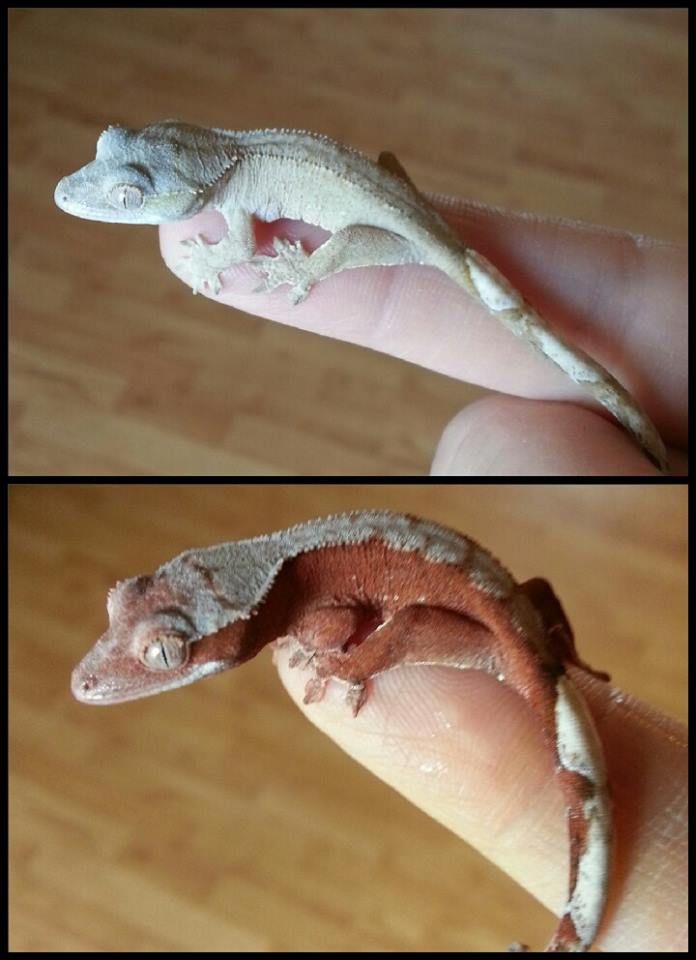 As a result, you may end up having to change terrariums a couple of times, and trust me, moving live plants from one enclosure to another can be very difficult.
As a result, you may end up having to change terrariums a couple of times, and trust me, moving live plants from one enclosure to another can be very difficult.
Therefore, you can use fake vines and plants in lieu of live ones. These fake plants may not be perfect, but they serve their purpose well while being easy to manage. You can combine the fake vines with a couple of branches to give your enclosure a more natural feel.
How to Handle a Baby Crested Gecko
Baby crested gecko on the tip of my finger!The size of a crested gecko will determine how you should handle them. A freshly hatched baby crested gecko is tiny, weighing a meager 2 grams and measuring 2.5 to 3 inches in length. Therefore, when handling a baby crested gecko, you need to be extremely cautious. Squeezing, grabbing, or dropping them can result in injury or even death.
When handling your baby crested gecko, you’ll quickly realize these guys are extremely fast. Their speed will make it challenging to handle them.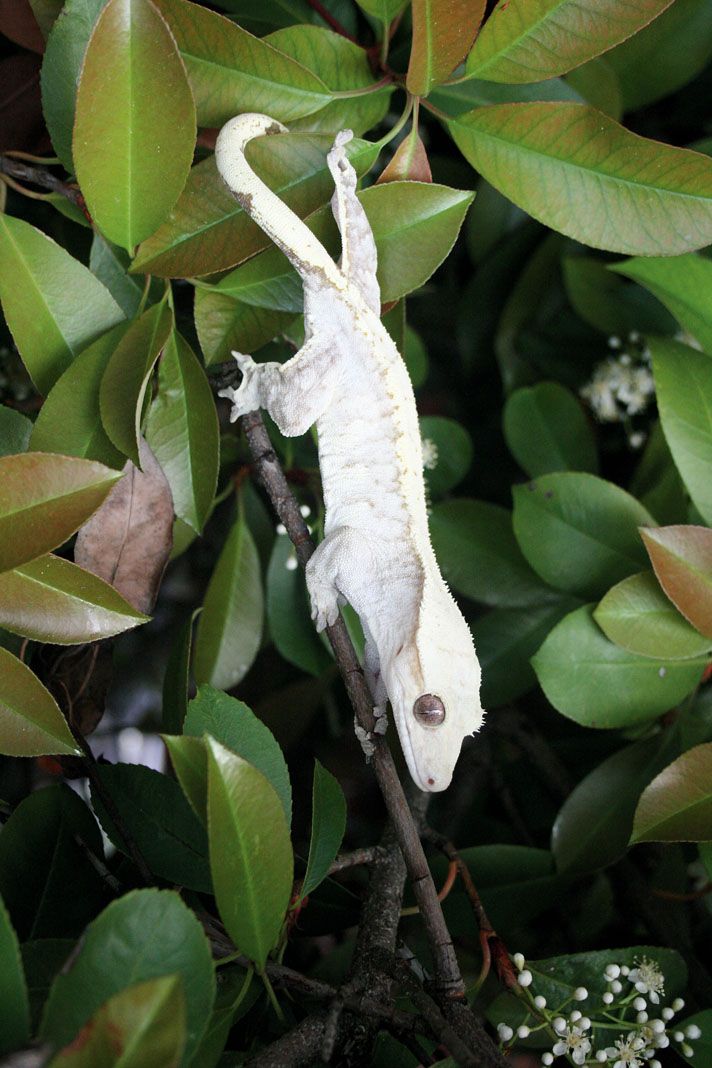 This is because they are yet to get used to getting held, and you’ll notice this when they wriggle away and probably jump out of your hands every time you try to handle them.
This is because they are yet to get used to getting held, and you’ll notice this when they wriggle away and probably jump out of your hands every time you try to handle them.
It can be pretty risky when they behave this way. For instance, they may jump off, fall on a hard surface, and hurt themselves in the process, which is why you should limit handling them to the minimum frequency possible. Only do it when it is necessary, like when it’s time to weigh and measure. Even then, exercise caution and never grab your crested gecko by the tail if you don’t want to stress them and cause tail loss.
You can also still fulfill your terrarium cleaning duties, but try to do so without disturbing the gecko. You will gradually learn how to handle your crested gecko as they grow and your relationship will grow stronger as they grow older.
Here are other useful tips on handling your baby crested gecko:
- Replace the food and water when your crestie is asleep to reduce stress.
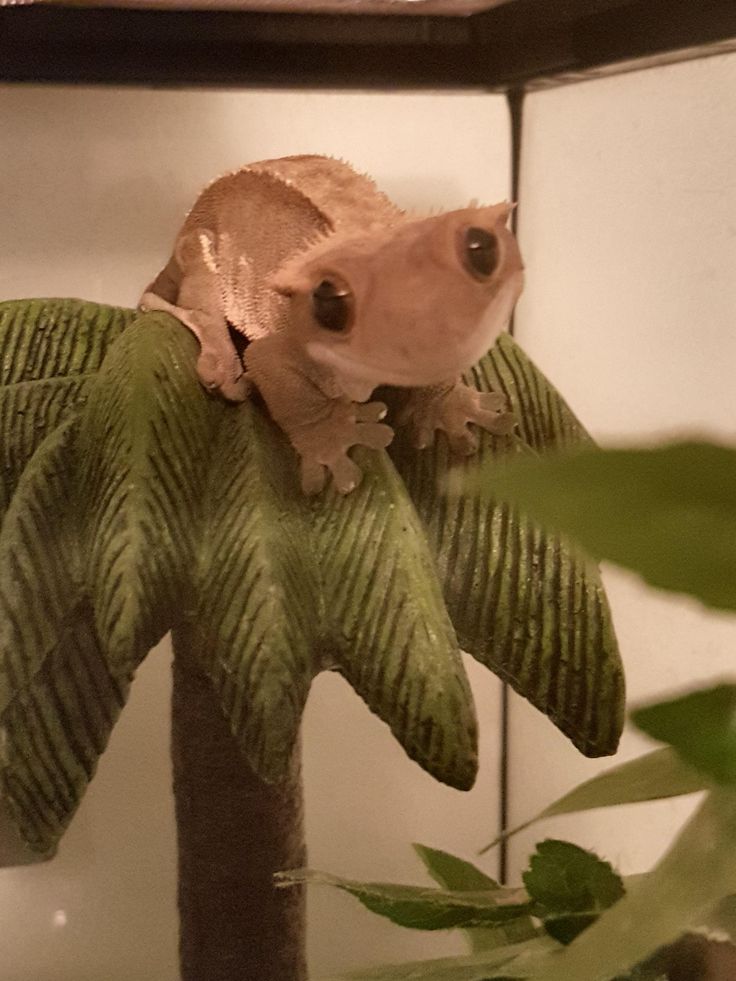
- When cleaning the enclosure, put your gecko on a branch rather than handling them the whole time.
- Before handling your baby crestie, create a calm atmosphere by eliminating any noises likely to startle them. Reduce the TV’s volume and ask your kids (if any) to keep calm and stop running around. This will make them less alert and less likely to run and jump around.
- The hand walking technique is an excellent first step to handling your cresties. You basically allow your gecko to move as they please along your arms. Do this for one or two minutes every day when they are around three months old and gradually increase the hand walking time to as long as 15 minutes.
Health
As you raise your baby crested geckos, there are a couple of health issues you should pay close attention to, with the most common being shedding. Hatchlings shed at a much faster rate than adults (once every week), making them more susceptible to stuck shed and dehydration. If left unchecked, stuck shed constricts blood flow to the affected part of the body, which leads to discomfort, injury, and even amputation. Thus, you should watch out for signs of unshed skin around the toes and tail area every week.
If left unchecked, stuck shed constricts blood flow to the affected part of the body, which leads to discomfort, injury, and even amputation. Thus, you should watch out for signs of unshed skin around the toes and tail area every week.
Taming a Baby Crested Gecko
All pet owners naturally want to tame and create a bond with their animals. For baby cresties under three months, this can be quite challenging as they are still trying to figure out their environment. Therefore, you need to be patient and take things slow and easy.
Before making any serious attempts to bond with your gecko, give them enough time to get used to your presence and their new home. Your crestie may not have the best of eyesight, but they have a relatively good sense of smell. Therefore, they will eventually learn to recognize your presence by your scent and associate it with good things like food. As your young crestie gets used to you, you can try to strengthen this bond by feeding them from your hand.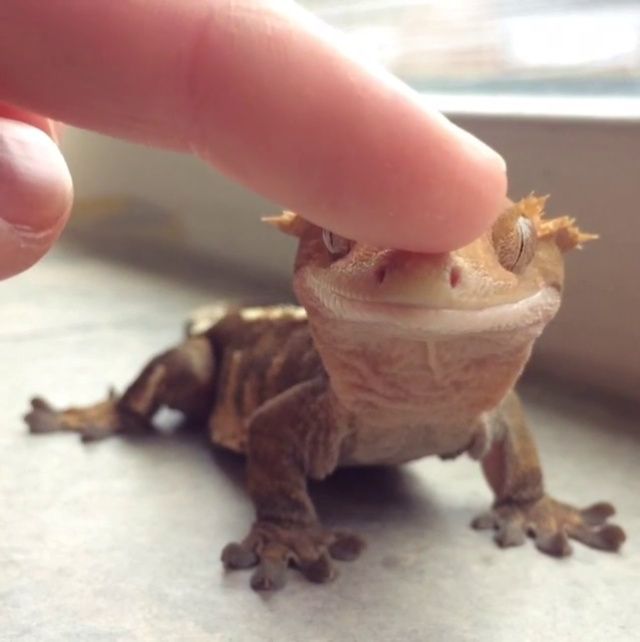
Frequently Asked Questions About Baby Crested Geckos
How often do baby crested geckos eat?
Since they are growing at a much faster rate, baby crested geckos eat more often than adults. They don’t really need to eat every day, but you should feed them four to five times a week.
Can you house baby crested geckos together?
Baby crested geckos are small, so you can fit a couple in a normal-sized terrarium. However, you should separate them once they reach six months since they will be too large to fit in one.
Do baby crested geckos bite?
When a crested baby gecko doesn’t want to be handled, they may bite. Don’t worry though; it won’t hurt or cause any serious injury.
Can a baby crested gecko drink tap water?
Unless the water is contaminated, drinking tap water is perfectly fine for your crested gecko. Some people raise concerns over the chlorine present in tap water, but this hasn’t been proven to cause any harm to a crestie.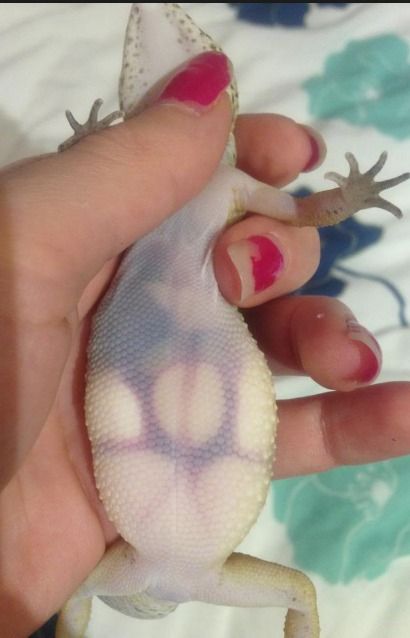
Summary
For many people, rearing baby cresties for the first time is accompanied by a lot of uncertainty. Still, with our guide, you will successfully raise your small and fragile hatchling into happy, healthy adults. All you need to do is provide proper housing, handle them with care, and feed them a nutritious diet. Good luck!
Eyelash Gecko Care - zootut.art
Natalia | May 16, 2021 | Veterinary | 1 comment
Crested geckos were once thought to be extinct, but were "rediscovered" around 1994. Since then, their popularity as pets has steadily grown.
This is a low maintenance pet, well suited for children or first-time lizard owners who have little time for daily care. One of their distinguishing features is their eyelashes, which is why they are sometimes referred to as eyelash geckos.
How big do crested geckos grow?
15-25 cm.
How long do crested geckos live?
10-20 years old
COMMON NAMES: crested gecko, New Caledonian crested gecko, eyelash gecko.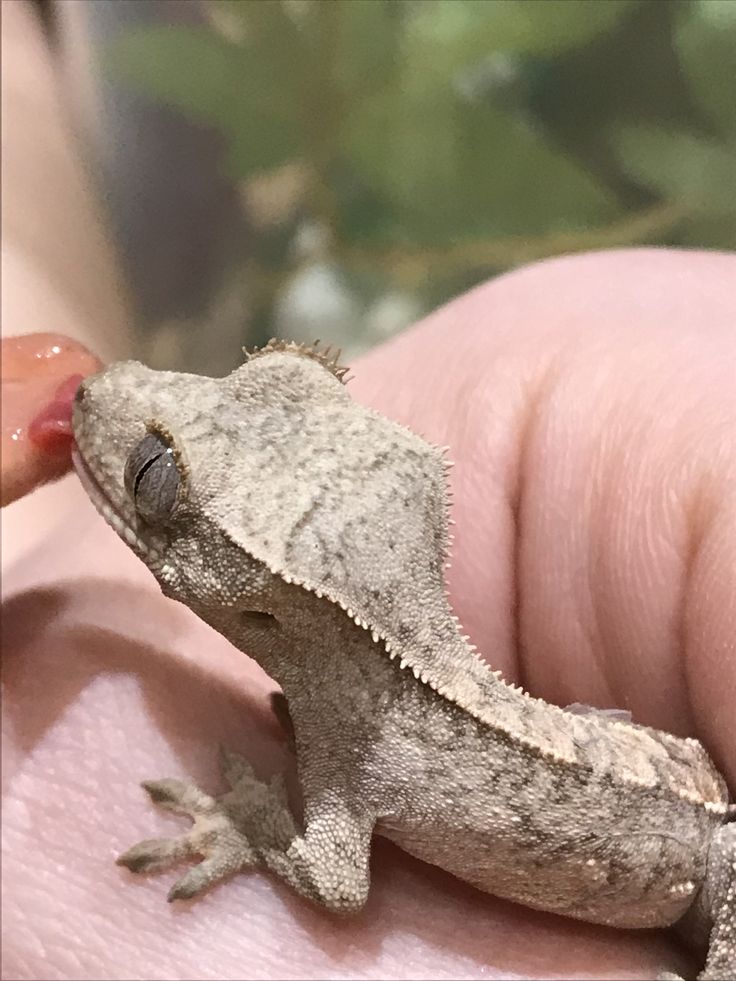
Crested gecko behavior and temperament
Crested geckos come in a wide variety of colors and patterns (morphs). They get their name from the fringed crest that starts above their eyes and runs down their neck and back, although the size of the crest varies.
Crested geckos have special toe pads that allow them to move easily on vertical surfaces, and prehensile tails add to their agility. They are also excellent jumpers.
Crested geckos generally have a relatively docile temperament, although they are a little shy and should be handled with care. They usually don't like manipulation, so avoid it if possible. They may try to jump away from you, which could injure them. Crested geckos may drop their tail if handled roughly or when trying to escape; unlike other geckos, they do not regenerate their tails.
They will only bite if they feel threatened. The bites are striking, although they do not cause pain and are not strong enough to cause bleeding.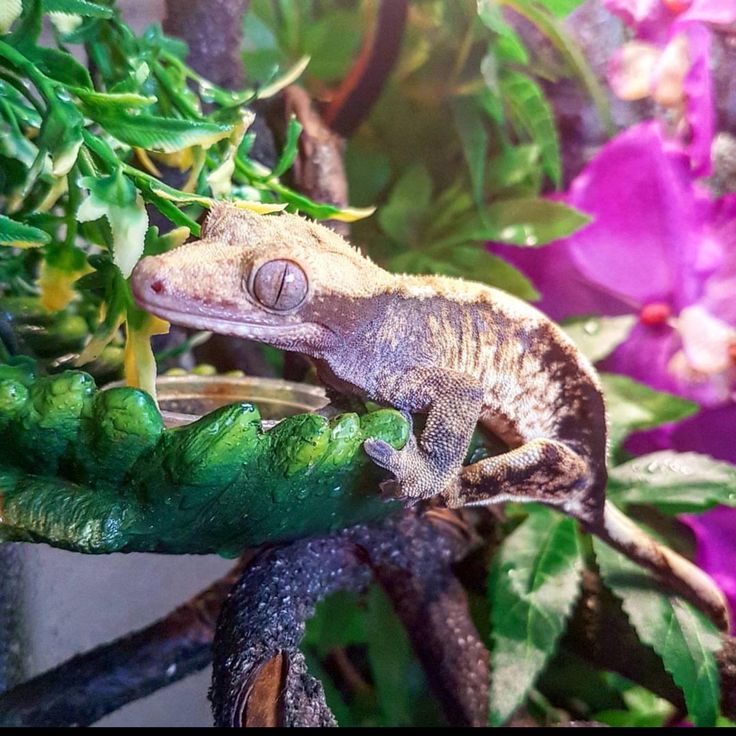
Keeping a crested gecko
For an adult, a terrarium at least 75 liters high is sufficient, but a larger aquarium is better. Crested geckos are arboreal, active and need a lot of vertical climbing space, so a tall aquarium is preferable. Two to three crested geckos can be housed in a 110 liter tall terrarium. Males are territorial, so keep only one male per tank. You can use a glass terrarium with a shielded side for ventilation, but some keepers prefer shielded aviaries.
Crested geckos need room to climb, so provide them with a mix of branches, driftwood, cork, bamboo, and vines of varying heights and orientations. Add a variety of silk or durable live plants (pothos, philodendron, dracaena, ficus) as they will burrow into the plants for cover. Every day you need to remove all uneaten food and clean fecal stains. Clean the entire terrarium and its decorations at least once a month using reptile-safe disinfectants. Depending on the substrate, you will need to replace it weekly or monthly to prevent bacterial growth.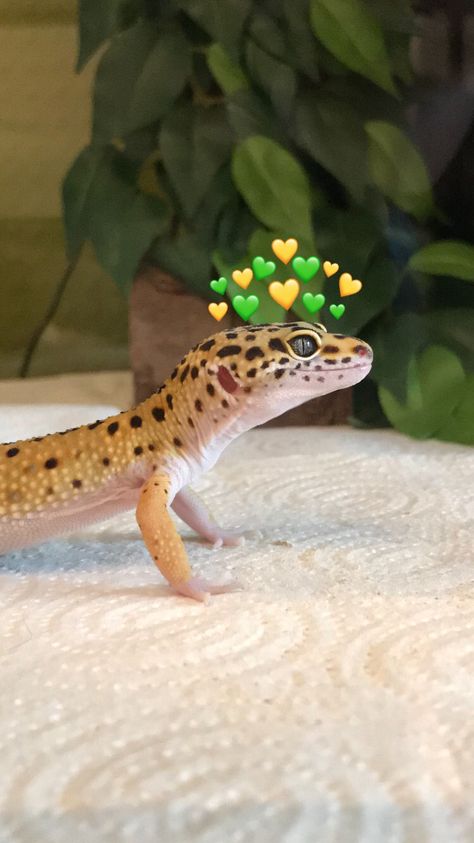
Crested gecko temperature regime
As cold-blooded creatures, all reptiles must regulate their body temperature. A daytime temperature gradient of 22 C to 26.5 C should be provided for crested geckos, dropping to 18 C to 24 C at night). Keep an eye on the temperature sensors to make sure the cage is not overheating. Crested geckos experience stress at higher temperatures. A low power red night light is a good source of heat and also allows you to observe the lizard at night when it is most active. Do not place a heat source on top of the tank as these climbing geckos can get too close and get burned.
Crested gecko lighting
Crested geckos are nocturnal; technically they don't need special UVB lighting. However, some experts suggest that low levels of UVB lighting (about 5 percent) are beneficial to the general health of reptiles. Any additional lighting will increase the temperature in the room, so keep an eye on it. Also, provide a gecko shelter so the geckos can run away from the light if they want to.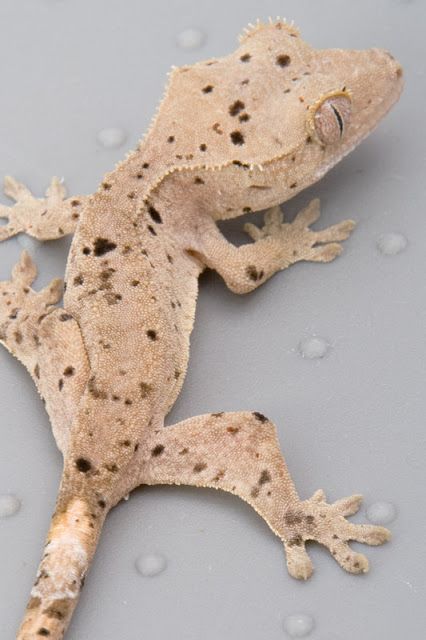
Humidity for crested gecko
Crested geckos require moderate to high humidity levels. Aim for 60% during the day and 80% at night. Purchase a hygrometer (humidity sensor) for daily level monitoring. Maintain moisture by misting regularly with warm, filtered water. Depending on your cage setup, you may need to mist it several times a day to keep it moist. Always make sure the cage is well misted at night when the geckos are most active. If you're not home during the day or can't physically mist up your aviary, get an automatic sprayer or fogger to add moisture to the cage at regular intervals.
Crested gecko food and water
Since they are nocturnal, feed crested geckos in the evening. Feed juveniles daily and adults three times a week.
The commercial crested gecko diet is generally well received and is the easiest way to provide a well balanced and nutritious diet. Supplement this food with crickets and other predatory insects (cockroaches, worms, silkworms). Avoid feeding mealworms as they have a hard, indigestible exoskeleton. For variety and for the gecko to show its hunting instincts, feed as many predatory insects at a time as the gecko willingly eats.
Avoid feeding mealworms as they have a hard, indigestible exoskeleton. For variety and for the gecko to show its hunting instincts, feed as many predatory insects at a time as the gecko willingly eats.
Insects to be fed should be slightly smaller than the space between the gecko's eyes and should be gut loaded or fed a nutritious meal before being fed to the lizard. To increase your reptile's vitamin and mineral intake, dust the insects with a powdered calcium/vitamin D3 supplement three times a week. Dust your prey with a multivitamin powder once a week.
Crested geckos will eat fruit several times a week. Try fruit puree or canned baby food. Favorites include bananas, peaches, nectarines, apricots, papaya, mangoes, pears and passion fruit.
If you are having trouble finding a commercial gecko diet, suggest a combination of insect food and fruit. This option is not the most balanced, but it will be enough in a pinch or for a short period. In this case, your best bet for insects is crickets, sometimes with other insects added for variety.
Give a small, shallow bowl of fresh water daily, although they are more likely to drink drops of leaf water in a humid environment.
General health problems
Geckos are prone to several health problems treated by an exotic veterinarian.
- Rot or stomatitis in the mouth : signs include excess mucus and redness around the mouth.
- Respiratory infection: symptoms are wheezing or salivation.
- Skin problems : rash, symptomatic parasitic infection; uneven or difficult casting, which may be caused by insufficient humidity in the room
About the author
Natalia
There are many formidable, kind and funny animals in the world. Everyone goes their own way, some with people, and some without them. Our cats and dogs have become family members. We separate their fights, give them our caresses. And in return with love, we receive this devotion in everything.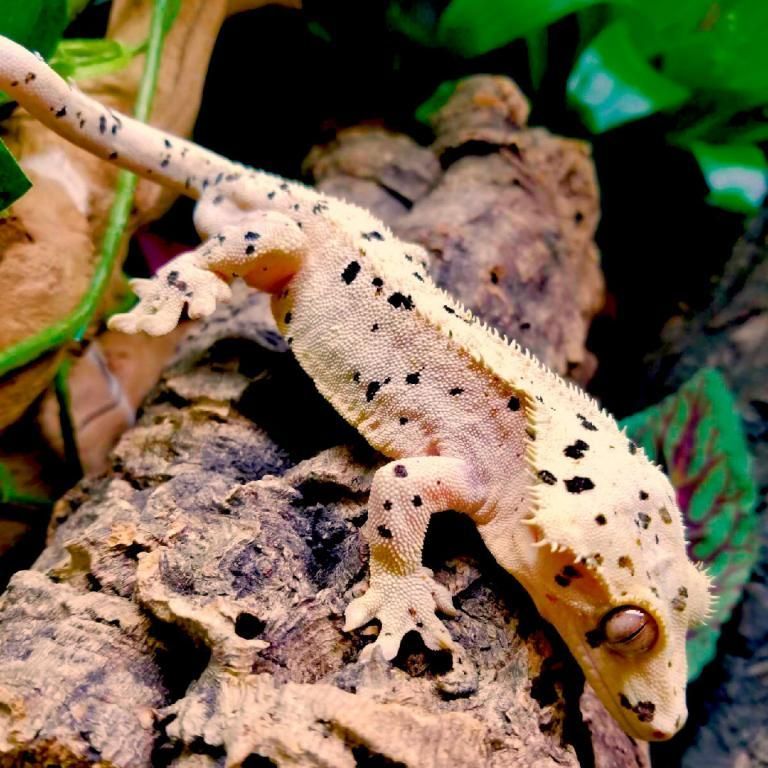 With respect and love!
With respect and love!
Can crested banana-eating geckos change color and why do they do it?
BANANA EYELASH GEKKO
Crested banana-eating geckos are beautiful lizards known for their patterns and colors, also called morphs. Some reptiles, such as chameleons, have the ability to change their color to blend in with their environment. So, do banana-eaters have the same ability to change color?
Can banana eaters change color?
Banana eaters can change their color. Color change can only be caused by aging. Cubs and juveniles usually have a different or different shade than when they are adults. Another color change process, when they are exposed to certain environmental influences . This process depends on various factors.
Banana eaters are limited in their ability to change color and cannot do so of their own accord. They will change their color when they grow up or when they are exposed to certain environmental influences. There is also another way your gecko's color can change temporarily, the molting cycle.
There is also another way your gecko's color can change temporarily, the molting cycle.
In this article, you will learn why the banana eater changes color and what environmental conditions can cause the color change.
Why do crested geckos change color?
There are three reasons why your gecko may change color:
- ontogenetic color change
- environmental discoloration (ignition)
- discoloration due to shedding
Age-related discoloration
- Banana eaters are born with a bright orange or red color and it is not possible to determine the adult color in the first few months. Your toddler or teen won't change color overnight, it will take several months to see the final color.
- At about 1 year old your banana eater, the adult color will be set. It may be a completely different color than the one the cub had. Like color, patterns are also associated with age.
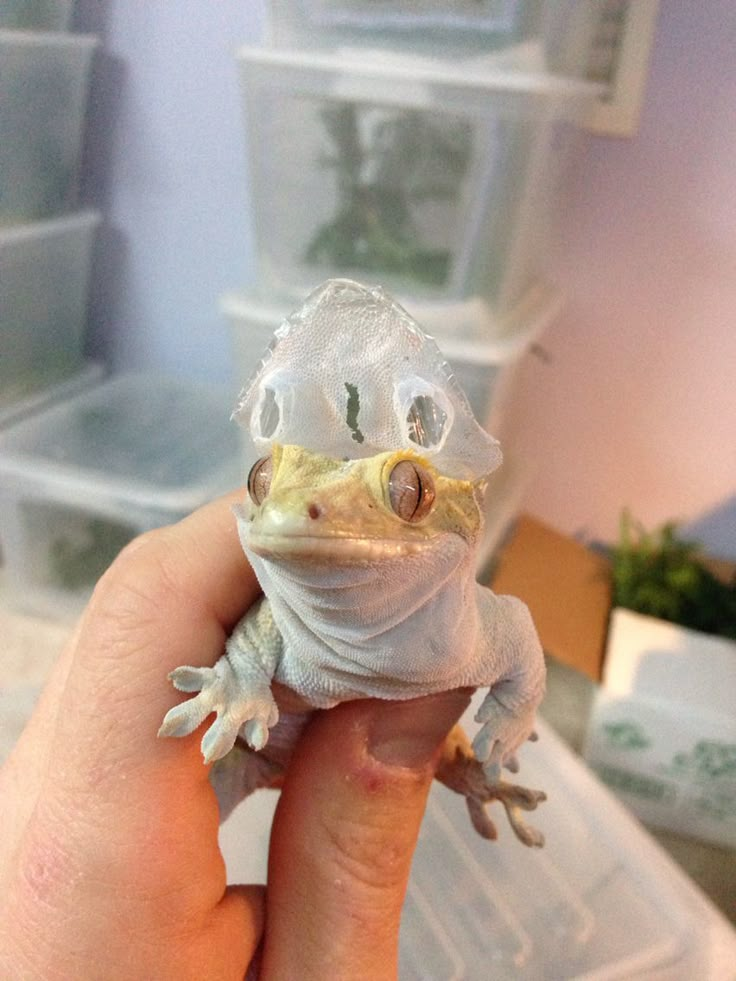 The hatchling will have few or no spots, but stripes and spots appear as they mature.
The hatchling will have few or no spots, but stripes and spots appear as they mature.
Environmental color change
Even adult banana eaters can still change their color, depending on many different factors. You may be influenced by some environmental conditions that may cause color change.
The most common reasons for a gecko to change color are:
- stress, fear, aggression : all of these moods can cause a gecko to change color. The stress and fear response can be triggered by a new environment, poor living conditions, overcrowding, or even reproduction.
- high humidity : Higher humidity around 70 percent may cause discolouration. These levels of humidity occur usually at night or in the morning.
- High temperature : Temperatures around 80 degrees Fahrenheit can cause a gecko to change color. Just don't expose them to high temperatures (above 85 degrees Fahrenheit) for long periods of time as this can cause overheating.
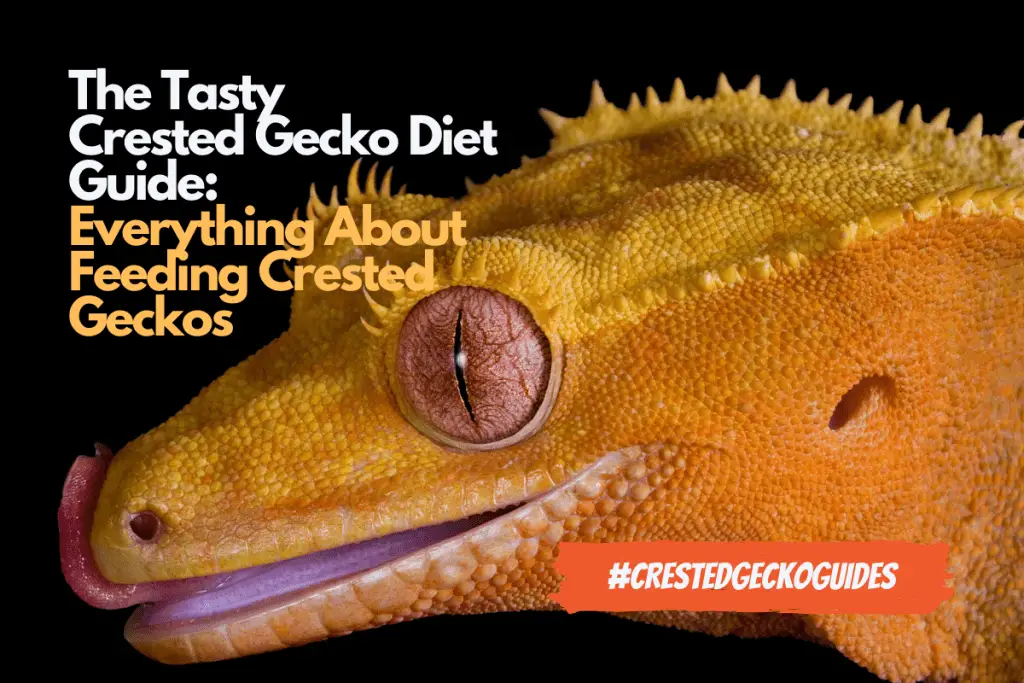
- illumination (or lack of light) : banana eaters often change color at night when there is little light. Perhaps this is a way to hide from predators by getting darker colors.
- activity : sleeping gecko usually has a duller color. When your banana eater becomes active at night, it usually darkens.
- Some of these reasons are interrelated. High humidity often occurs at night when there is little light and when your banana eater is active. It is not always possible to attribute the color change to one specific environmental trigger.
· Color change due to moulting
- Banana eaters, like other reptiles, shed their old skin and replace it with new skin. A few days before the start of the molt, you will notice that your banana eater turns gray or even turns pale. This is completely normal and nothing to worry about. Your banana eater will change its skin and return to its normal color in a few days.
